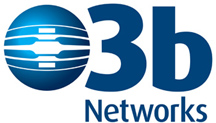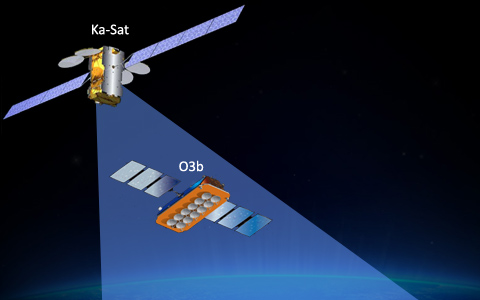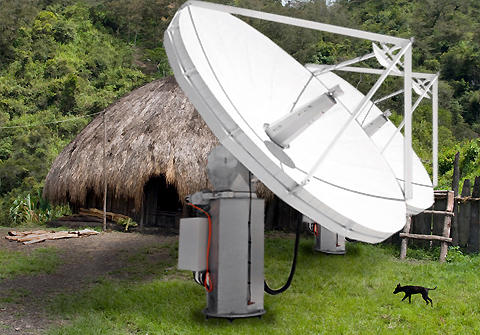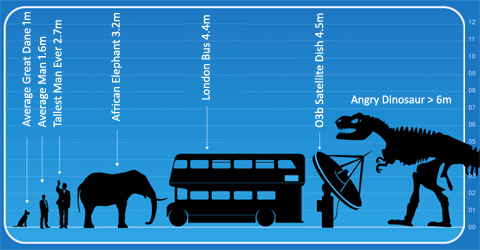Wednesday 24 July, 2013, 07:44 - Satellites
Posted by Administrator
Posted by Administrator
 Satellite officionados will no doubt be aware of 'O3b' but to the rest of the world, the launch of their first four satellites probably passed them by. O3b stands for 'other three billion' and is meant to highlight the plight of the significant proportion of the world's population who do not have access to high speed internet connections. O3b's role is to provide a 'backbone in the sky' which will allow places that are remote from terrestrial infrastructure to have high speed connections.
Satellite officionados will no doubt be aware of 'O3b' but to the rest of the world, the launch of their first four satellites probably passed them by. O3b stands for 'other three billion' and is meant to highlight the plight of the significant proportion of the world's population who do not have access to high speed internet connections. O3b's role is to provide a 'backbone in the sky' which will allow places that are remote from terrestrial infrastructure to have high speed connections.The idea is not that new. 20 years ago, Teledesic had much the same idea. The two networks share a lot of common features:
- They both use Ka-band spectrum (around 18 and 28 GHz). At these frequencies, even small dishes have very narrow beams, requiring accurate pointing.
- They both use low(er) orbits than the geostationary arc. The lower orbits reduce the time delay normally associated with satellite communications but require that the dishes are able to track the movement of the satellites.
- They both have big-name backers. Microsoft was an investor in Teledesic. Google is an investor in O3b.
Wireless Waffle has discussed the different bands used by satellites before. Ka-Band is the band of choice for new broadband satellites as it's used less than the now almost saturated Ku-Band. The thing is that there are an increasing number of satellites using the band, the majority of which are in geostationary orbits. As the O3b satellites are in a medium earth orbit (MEO), and thus move through the sky when seen from the ground, it is quite feasible that they could end up positioned between a dish on the ground, and a geostationary satellite. In these cases, there is the potential for the O3b satellite to cause interference to the dish on the ground. As there are potentially millions of such dishes, ensuring that the O3b constellation is 'switched off' when it is in a position to cause such interference is an interesting technical challenge.

Then there's the issue that as the satellites appear to move in the sky, ground stations for O3b would require tracking dishes. Much development has been done to try and develop dishes which can track the movement of satellites without the dish itself needing to move. Such dishes would be ideal for use on trains, aircraft or cruise ships to circumvent the need for tracking dishes on moving vehicles. The same idea could be applied to ground stations that are fixed but satellites that move. However this is not the plan for O3b. The plan is to have traditional steerable satellite dishes which track the satellite through the sky. And as it takes time to move a dish around, two will be used with the second picking up a connection from a second satellite as the first dish loses its connection when the satellite passes over the horizon.
Two steerable dishes makes for a complex system and one which will require significant and regular maintenance costs, and maintenance by skilled engineers who are not (currently) likely to be present in large numbers in the kinds of areas that O3b wishes to serve. There is also the question of what happens when the service is handed over from one satellite to another. Such a hand-over could introduce a variable delay in the connection (technically, known as 'jitter'). One solution to this would be to have a buffer to stabilise the connection, but adding a buffer adds a delay and it is precisely to try and reduce delay that the satellites are in a lower orbit to start with. Oops!
Current Ka-band satellite services typically offer connection speeds of around 20 Mbps and use 65 or 80 cm dishes. Delivering 600 Mbps requires a bit more effort and as such the steerable dishes for O3b will each be 4.5 metres in size! At Ka-Band this means they will have a beamwidth of less than 0.2 of a degree, requiring highly accurate tracking. Not to mention the fact that 4.5 metre dishes are large and heavy and take up a lot of space. If you think about the intended market for O3b, which is rural area far from traditional infrastructure of any kind, running two, highly accurate, steerable 4.5 metre dishes is not the kind of technology which would easily blend in with the environment. And where do you get a power source to drive them with?

Putting these technical issues aside for a minute, there is then the question of speed to market. Many of the far flung places that O3b is looking to serve are already beginning to be connected via fibre, whether undersea or overland. Take the Pacific Islands, slowly but surely, these are being connected to the world via subsea fibre. Fiji, Guam and Hawaii have long had connections, but Norfolk Island, New Caledonia, Vanuatu, Wallis, Samoa and American Samoa are due to be connected via a project called Hawaiki Cable (though it's fair to say that a previous such projects known as SPIN did not materialise). Perhaps O3b has the upper hand here, then again if Hawaiki goes ahead, it will offer connection speeds nearly a thousand times faster than O3b.
Would you pour your hard earned money into O3b shares? Don't decide just yet as there's one other issue we need to talk about... the Van Allen belt. You may have heard of this. It's a region of space above the Earth which is full of particles charged by solar energy but trapped by the Earth's gravity. It is one of the more unfriendly space environments and the O3b satellites flying at just over 8000 km above the Earth will sit right in the middle of it. This gives them around 100 times the dose of radiation that a satellite in geostationary orbit would experience and as a result makes them more susceptible to radiation damage of various kinds. There are currently no commercial satellites (other than O3b) operating in the Van Allen belt.
Of course all these obstacles are worth the effort if the end services can be supplied more cheaply than competing technologies. O3b's pricing is not yet clear but it will have to compete with other Ka-band services such as Inmarsat's Global Xpress. This will give you a connection of up to 50 Mbps for prices purported to be around US$3000 per month. At rates of income in some countries, it would require an awful lot of users to club together to raise that kind of finance. It is therefore to be hoped that O3b can offer a service that is more cost effective. With the cost of the dishes alone likely to be at least US$50000, that seems rather unlikely.

Perhaps a better description of O3b would be 'over 3m big'. Still, it looks as if their dishes will provide good protection against angry dinosaurs!
add comment
( 2904 views )
| permalink
| 



 ( 2.9 / 1682 )
( 2.9 / 1682 )




 ( 2.9 / 1682 )
( 2.9 / 1682 )

